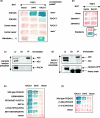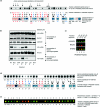Scanning peptide array analyses identify overlapping binding sites for the signalling scaffold proteins, beta-arrestin and RACK1, in cAMP-specific phosphodiesterase PDE4D5
- PMID: 16689683
- PMCID: PMC1525009
- DOI: 10.1042/BJ20060423
Scanning peptide array analyses identify overlapping binding sites for the signalling scaffold proteins, beta-arrestin and RACK1, in cAMP-specific phosphodiesterase PDE4D5
Abstract
The cAMP-specific phosphodiesterase PDE4D5 can interact with the signalling scaffold proteins RACK (receptors for activated C-kinase) 1 and beta-arrestin. Two-hybrid and co-immunoprecipitation analyses showed that RACK1 and beta-arrestin interact with PDE4D5 in a mutually exclusive manner. Overlay studies with PDE4D5 scanning peptide array libraries showed that RACK1 and beta-arrestin interact at overlapping sites within the unique N-terminal region of PDE4D5 and at distinct sites within the conserved PDE4 catalytic domain. Screening scanning alanine substitution peptide arrays, coupled with mutagenesis and truncation studies, allowed definition of RACK1 and beta-arrestin interaction sites. Modelled on the PDE4D catalytic domain, these form distinct well-defined surface-exposed patches on helices-15-16, for RACK1, and helix-17 for beta-arrestin. siRNA (small interfering RNA)-mediated knockdown of RACK1 in HEK-293 (human embryonic kidney) B2 cells increased beta-arrestin-scaffolded PDE4D5 approx. 5-fold, increased PDE4D5 recruited to the beta2AR (beta2-adrenergic receptor) upon isoproterenol challenge approx. 4-fold and severely attenuated (approx. 4-5 fold) both isoproterenol-stimulated PKA (protein kinase A) phosphorylation of the beta2AR and activation of ERK (extracellular-signal-regulated kinase). The ability of a catalytically inactive form of PDE4D5 to exert a dominant negative effect in amplifying isoproterenol-stimulated ERK activation was ablated by a mutation that blocked the interaction of PDE4D5 with beta-arrestin. In the present study, we show that the signalling scaffold proteins RACK1 and beta-arrestin compete to sequester distinct 'pools' of PDE4D5. In this fashion, alterations in the level of RACK1 expression may act to modulate signal transduction mediated by the beta2AR.
Figures








Similar articles
-
1H NMR structural and functional characterisation of a cAMP-specific phosphodiesterase-4D5 (PDE4D5) N-terminal region peptide that disrupts PDE4D5 interaction with the signalling scaffold proteins, beta-arrestin and RACK1.Cell Signal. 2007 Dec;19(12):2612-24. doi: 10.1016/j.cellsig.2007.08.015. Epub 2007 Sep 1. Cell Signal. 2007. PMID: 17900862
-
RNA silencing identifies PDE4D5 as the functionally relevant cAMP phosphodiesterase interacting with beta arrestin to control the protein kinase A/AKAP79-mediated switching of the beta2-adrenergic receptor to activation of ERK in HEK293B2 cells.J Biol Chem. 2005 Sep 30;280(39):33178-89. doi: 10.1074/jbc.M414316200. Epub 2005 Jul 19. J Biol Chem. 2005. Retraction in: J Biol Chem. 2025 Mar;301(3):108141. doi: 10.1016/j.jbc.2024.108141. PMID: 16030021 Retracted.
-
Delineation of RAID1, the RACK1 interaction domain located within the unique N-terminal region of the cAMP-specific phosphodiesterase, PDE4D5.BMC Biochem. 2002 Aug 23;3:24. doi: 10.1186/1471-2091-3-24. BMC Biochem. 2002. PMID: 12193273 Free PMC article.
-
cAMP-specific phosphodiesterase-4D5 (PDE4D5) provides a paradigm for understanding the unique non-redundant roles that PDE4 isoforms play in shaping compartmentalized cAMP cell signalling.Biochem Soc Trans. 2007 Nov;35(Pt 5):938-41. doi: 10.1042/BST0350938. Biochem Soc Trans. 2007. PMID: 17956250 Review.
-
The cyclic AMP phosphodiesterase 4D5 (PDE4D5)/receptor for activated C-kinase 1 (RACK1) signalling complex as a sensor of the extracellular nano-environment.Cell Signal. 2017 Jul;35:282-289. doi: 10.1016/j.cellsig.2017.01.013. Epub 2017 Jan 6. Cell Signal. 2017. PMID: 28069443 Review.
Cited by
-
MEK1 binds directly to betaarrestin1, influencing both its phosphorylation by ERK and the timing of its isoprenaline-stimulated internalization.J Biol Chem. 2009 Apr 24;284(17):11425-35. doi: 10.1074/jbc.M806395200. Epub 2009 Jan 19. J Biol Chem. 2009. PMID: 19153083 Free PMC article.
-
Phosphodiesterase 4D activity in acrodysostosis-associated neural pathology: too much or too little?Brain Commun. 2024 Jun 29;6(4):fcae225. doi: 10.1093/braincomms/fcae225. eCollection 2024. Brain Commun. 2024. PMID: 38983619 Free PMC article. Review.
-
p75 neurotrophin receptor regulates tissue fibrosis through inhibition of plasminogen activation via a PDE4/cAMP/PKA pathway.J Cell Biol. 2007 Jun 18;177(6):1119-32. doi: 10.1083/jcb.200701040. J Cell Biol. 2007. PMID: 17576803 Free PMC article.
-
RACK1 associates with muscarinic receptors and regulates M(2) receptor trafficking.PLoS One. 2010 Oct 20;5(10):e13517. doi: 10.1371/journal.pone.0013517. PLoS One. 2010. PMID: 20976005 Free PMC article.
-
RACK1, A multifaceted scaffolding protein: Structure and function.Cell Commun Signal. 2011 Oct 6;9:22. doi: 10.1186/1478-811X-9-22. Cell Commun Signal. 2011. PMID: 21978545 Free PMC article.
References
-
- Hall R. A. β-Adrenergic receptors and their interacting proteins. Semin. Cell. Dev. Biol. 2004;15:281–288. - PubMed
-
- Lefkowitz R. J., Shenoy S. K. Transduction of receptor signals by β-arrestins. Science. 2005;308:512–517. - PubMed
-
- Wong W., Scott J. D. AKAP signalling complexes: focal points in space and time. Nat. Rev. Mol. Cell. Biol. 2004;5:959–970. - PubMed
-
- Penela P., Ribas C., Mayor F., Jr Mechanisms of regulation of the expression and function of G protein-coupled receptor kinases. Cell. Signalling. 2003;15:973–981. - PubMed
-
- Baillie G. S., Houslay M. D. Arrestin times for compartmentalised cAMP signalling and phosphodiesterase-4 enzymes. Curr. Opin. Cell. Biol. 2005;17:129–134. - PubMed
Publication types
MeSH terms
Substances
Grants and funding
LinkOut - more resources
Full Text Sources
Other Literature Sources
Miscellaneous

